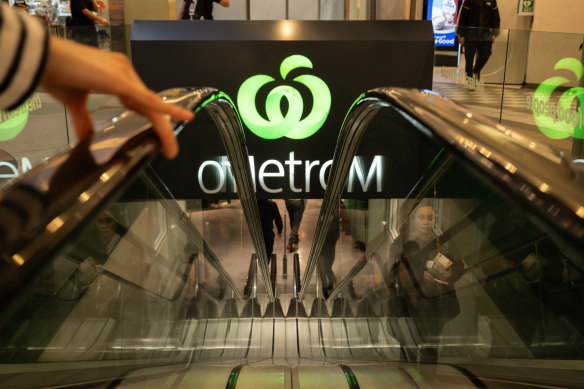Opinion
Profit under pressure: Woolworths shareholders take one for the team
Elizabeth Knight
Business columnistWhether Woolworths has been pummelled into submission by Canberra’s political rabble or is simply caught in a battle for market share, the result is it has lowered prices and will sacrifice profit.
All political parties will tout this as a win in their fight against what they brand as price-gouging by Australia’s supermarkets. Beating up supermarkets has become a game of political one-upmanship over the past nine months – Labor, the Coalition and the Greens will be vying for the trophy.
But it’s Woolworths shareholders who will be taking one for the team, as highlighted by the grocery giant’s warning on Wednesday that profit at its supermarkets will fall by as much as $115 million in the first half of the current financial year from the same period last year.

Food prices aren’t the only thing going down at Woolworths: So are profits and the share price.Credit: Louie Douvis
Average food prices at Woolworths dropped 0.3 per cent in the three months to September (or 0.8 per cent, if you exclude tobacco) following deflationary moves during the previous two quarters.
Yet food prices aren’t the only thing falling at Woolworths: Its share price has fallen harder and faster.
For newly minted chief executive Amanda Bardwell, the political and customer pincer has squeezed her pricing options. This isn’t a mess of her making. But she will be judged on the clean-up.
Bardwell expects the value-conscious customer will remain on the rise for the rest of the financial year.
A legal accusation by the Australian Competition and Consumer Commission that Woolworths and Coles have misled customers with false discounts on hundreds of products has been wildly damaging for the nation’s biggest supermarkets and placed them in defence mode.
No new chief executive wants to deliver a profit warning in their first reporting period, but Bardwell had little choice.
She needs to rebuild customer trust, regardless of whether the ACCC or the government can mount a case that it has been abused.
Now, all eyes will be on Coles when it delivers its first quarter of sales on Thursday.
In the near term, Bardwell needs to convey to Canberra and Woolies’ customers that she is responding to the cost-of-living crisis rather than the ker-ching of the cash register.
Woolworths doesn’t just have Coles as its only meaningful competitor anymore, thanks to customers getting more creative about reducing their grocery bills. They are shopping around at unprecedented levels and bringing the likes of Aldi and Amazon into the mix.
Customers have not only abandoned much of their supermarket brand loyalty; they are shopping differently.
There is an increase in the proportion of online sales, which have lower profit margins for Woolworths. There is also a huge push by shoppers towards substituting the brands they have always used with cheaper house-brand products.
Woolworths’ sales growth in the opening quarter of the 2025 financial year was a pretty robust 3.8 per cent in Australian food, thanks to an improvement in volumes of goods sold. But not surprisingly, discounts have eaten into margins and profits.
Shareholders delivered their verdict on Woolies’ predicament on Wednesday, pushing the share price down almost 6 per cent. The price has dropped 15 per cent since the end of August.
The share price trouble bled into Coles’ share price, which was off 2.4 per cent.
Yet whether the hit to profits in the December half is the worst of it remains to be seen. Woolworths predicts its first-half earnings to come in at between $1.48 billion and $1.53 billion.
Bardwell expects the value-conscious customer will remain on the rise for the rest of the financial year.
And there’s no doubt that in the lead-up to next year’s federal election, all political parties will keep their feet on the anti-supermarket pedal. It is clearly gaining traction.
The Market Recap newsletter is a wrap of the day’s trading. Get it each weekday afternoon.